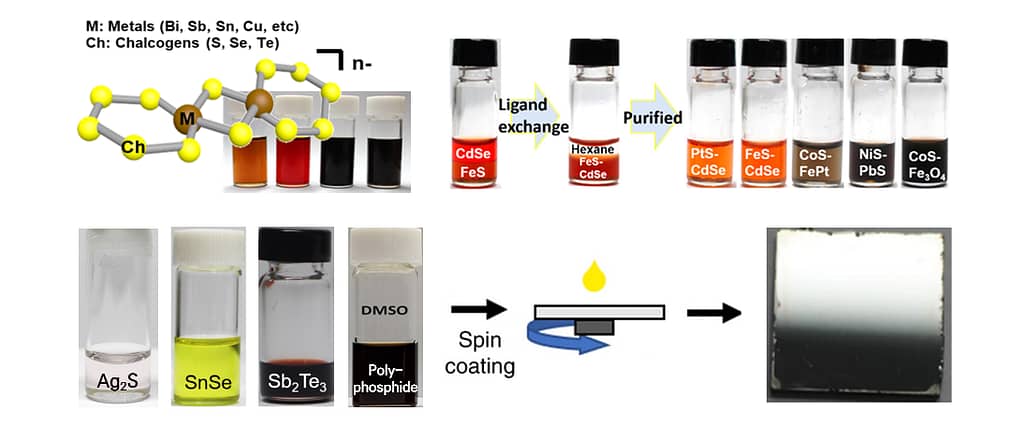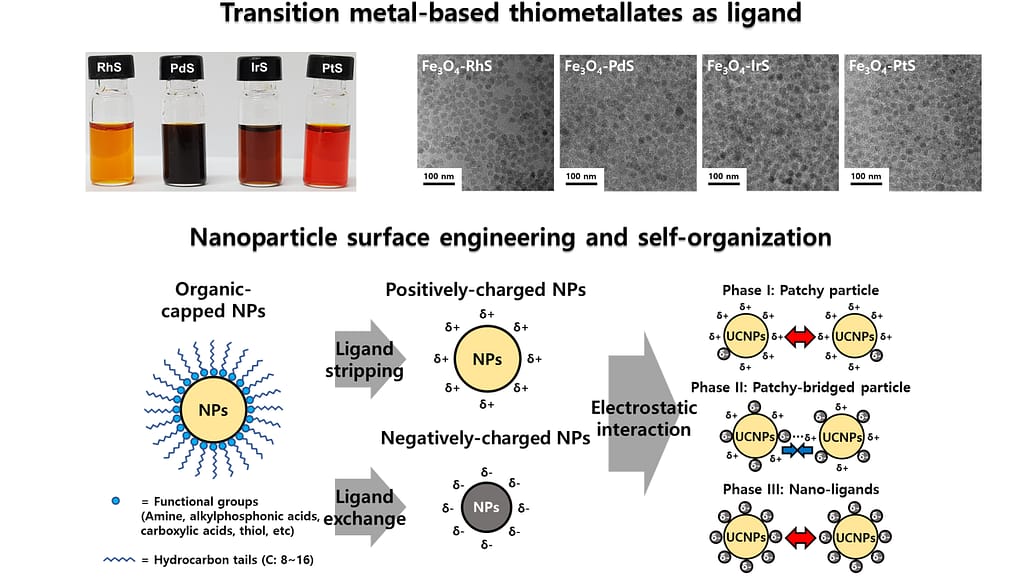Synthesis
Soluble inorganics
Facile dissolution of inorganics can offer a convenient route to exploit inorganic materials as sintering aids of mesoscale particles, ligands for nanoparticles and precursors for wet-chemical deposition of thin films. Inorganic materials can be directly dissolved in nucleophilic environment induced by excess chalcogen in hydrazine or deprotonated thiol in solvent mixture with amine. The nucleophiles in these solvents react with bulk inorganics breaking down them into molecular inorganic anions. Moreover, such inorganic molecules could be synthesized by traditional coordination chemistry route. We study for basic understanding on the role of molecular inorganics interacting with micro- and nano-scale building blocks, and utilize them for 2D or 3D architecturing of functional materials.

Relevant publication
– Jo, et al. Ink processing for thermoelectric materials and power generating devices. Adv. Mater. 2018, 1804930.
– Jeong, et al. Transition metal-based thiometallates as surface ligands for functionalization of all-inorganic nanocrystals. Chem. Mater. 2017, 29, 10510-10517.
– Zhang, et al. Soluble lead and bismuth chalcogenidometallates: Versatile solders for thermoelectric materials. Chem. Mater. 2017, 29, 6396–6404.
– Ban, et al. Molybdenum and Tungsten Sulfide Ligands for Versatile Functionalization of All-Inorganic Nanocrystals. J. Phys. Chem. Lett. 2016, 7, 3627-3635.
– Jo, et al. Simultaeneous improvement in electrical and thermal properties of interface-engineered BiSbTe nanostructured thermoelectric materials. J. Alloy. Compd. 2016, 689, 899-907.
– Park, et al. High performance shape-engineerable thermoelectric painting. Nat. Commun. 2016, 7, 13403.
– Donzhnikov, et al. Composition-matched molecular “solders” for semiconductors. Science 2015, 347, 425-428.
Nanocrystals
We have endeavored to synthesize various nanocrystals with different size, shape, and composition across various material types such as metals, semiconductors, and oxides by the colloidal chemical route to adopt nanocrystals as effective building blocks, and characterize those nanocrystals to observe changes in properties according to conditions.
Our goal is to fabricate multi-dimensional architectures through various processes using colloidal nanocrystal building blocks exhibiting unique and tailored properties.

Relevant publication:
– Choo, et al. Synthesis of Inorganic–Organic 2D CdSe Slab‐Diamine Quantum Nets. Small 2019, 15, 1804426.
– Jeong, et al. Technology Trend of Luminescent Nanomaterials. J. Korean Powder Metall. Inst. 2018, 25, 170-177.
– Bang, et al. Large-Scale Synthesis of Highly Luminescent InP@ZnS Quantum Dots Using Elemental Phosphorus Precursor. Chem. Mater. 2017, 29, 4236-4243.
– Gu, et al. Colloidal Synthesis of Te-Doped Bi Nanoparticles: Low-Temperature Charge Transport and Thermoelectric Properties. ACS Appl. Mater. Interfaces 2017, 9, 19143-19151.
– Yang, et al. Route to the Smallest Doped Semiconductor: Mn2+-Doped (CdSe)13Clusters. J. Am. Chem. Soc. 2015, 137, 12776-12779.
– Kim, et al. Near-Room Temperature Synthesis of Core/Shell-structured Quantum Dots. J. Nanosci. Nanotechnol. 2015, 15, 7146-7152.
– An, et al. Hollow MmOxPy and Pt/MoOxPy yolk/shell nanoparticles as a T1 MRI contrast. J. Colloid Interface Sci. 2015, 439, 134-138.
– Park, et al. Colloidal synthesis and thermoelectric properties of La-doped SrTiO3 nanoparticles. J. Mater. Chem. A 2014, 2, 4217-4224.
Surface chemistry

Relevant publication:
– Zhang, et al, Soluble Lead and Bismuth Chalcogenidometallates: Versatile Solders for Thermoelectric Materials. Chem. Mater. 2017, 29, 6396–6404.
– Jeong, et al, Transition Metal-Based Thiometallates as Surface Ligands for Functionalization of All-Inorganic Nanocrystals. Chem. Mater. 2017, 29, 10510-10517.
– Ban, et al, Molybdenum and Tungsten Sulfide Ligands for Versatile Functionalization of All-Inorganic Nanocrystals. J. Phys. Chem. Lett. 2016, 7, 3627-3635.
– Donzhnikov, et al. Composition-matched molecular “solders” for semiconductors. Science. 2015, 347, 425-428.